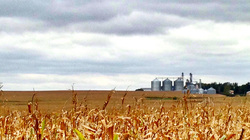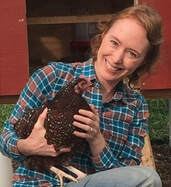
Biologically, the confusion can be summed up as "the omnivore's dilemma," but the truth is, we are much more confused about eating now than we were even less than a century ago.
For most of human history, humans have been eating whatever they could find in nature that was edible. The question of "what to eat" was virtually nonexistent. We ate whatever foods we could find growing on trees, bushes, plants, or in the ground. Of course, we had to learn things like what foods were poisonous to us, and which ones would make us sick, but otherwise eating was relatively confusion-free.
All this changed with the advent of modern industrial agriculture...
Instead of a focus on providing healthy and nutritious foods to feed our population, today's food system focuses on 2 things: efficiency and lowering costs. Unfortunately, this focus is not only damaging our planet, but our own health to boot.
Diet-related diseases are the most prevalent health issue in the developed world. This is both sad and alarming for the simple fact that they are so very preventable! Unfortunately, many people believe that eating healthy is so complicated (and expensive) that they can't possibly do it without studying mountains of data and poring over nutritional textbooks - or spending their whole paycheck at the big-box health foods store.
In fact, eating healthy couldn't be simpler. In the wise words of Michael Pollan, "Eat real food, mostly plants, not too much." Or, if you prefer my 2 rules, "Eat what God made. Eat it the way he made it."
Unfortunately, our American food system pays no attention to simple rules like this - nor to producing these kinds of foods...
The Plague of Cheap Food
The centralization of our food production means that fewer and fewer people produce the foods that we find in grocery stores today. In fact, just a few big monopolies now produce the vast majority of our food. The upside, at least on the surface, is that our food is much less expensive than it used to be as a percentage of our income. In fact, we have some of the cheapest food in the world - at least if you consider corn syrup and trans fats, which make up the bulk of our crop production other than animal feed, to be food.
But while our food may be cheap in dollars, it is incredibly costly in other ways. For example, we also spend more on healthcare than any other country in the world. A vast majority of our healthcare spending goes to treating preventable diseases caused by - guess what - eating cheap (and unhealthy) food!
In fact, according to research presented at the American Heart Association's Epidemiology meeting last year, eating one additional serving of fresh fruits and vegetables per day could save 3.5 million lives from heart disease in just 2 years' time!
Besides harming our own health, cheap food is also destroying our environment. The industrial model of agriculture (efficiency above all) is polluting our soil and water supply to such an extent that the ability to grow healthy food in the future is also being compromised.
Efficiency That's Not So...Efficient
Efficiency also means lack of diversity. Most of our crops are now produced in vast monoculture plots - mostly of corn and soybeans. Instead of the diverse eco-web of plant and animal species living together in a symbiotic relationship, we have vast farmlands where only one crop grows, supported by tons of fossil-fuel-based synthetic fertilizers that kill beneficial soil microbes and pollute our waterways, while animals are raised in CAFOs surrounded by toxic manure lagoons! Does this strike anyone else as positively loony?
As Mercola's article says, "The separation of crops and animals into two distinctly different processes has also led to waste becoming a massive source of pollution rather than a valuable part of the ecological cycle."
Livestock is key to healthy farming, as is diversity of crop species. By separating the two, our food system is leading us down a truly inefficient path to environmental destruction and an epidemic of modern disease.
Is There A Solution?
If we want things to change, first of all, we need to recognize that there is a problem and make this conversation a priority to our government and food policy makers.
Although progress is slow, a few areas have already started to make strides in this regard. While many inner cities are some of the most unhealthy areas in our nation due to lack of sources of healthy and affordable food, there are a few programs springing up to help rectify this situation. For example, Harvest Home, a non-profit in New York City, is helping to develop farmers markets in low-income neighborhoods. These markets are set up to accept food stamps for their customers who are on assistance programs. They also provide additional savings coupons for spending on fresh produce at the markets, as does Michigan's "double-up food bucks" program, which works with farmers, farmer's markets, and grocery stores to match food stamp dollars spent on produce with additional food coupons for more fresh produce.
These methods of encouraging more consumption of healthy fruits and vegetables are already making a difference in these communities. (For more info, check out Food Forward on PBS.)
Another thing you can do - where possible - is to grow at least some of your own food. This is by far the most direct way to take back control of your food supply! Some estimates have shown that transforming just 10% of America's 35 million acres of lawn into food-producing gardens could supply 1/3 of our country's need for fresh produce. Plus, by employing organic methods, you can help to rebuild our precious soils, nourish our ecosystem, and reduce runoff of polluting chemicals into our water supplies. (Need help getting started? Check out our Sustainable Gardening blog for lots of helpful articles and tips for growing your own organic, sustainable garden!)
Lastly, remember that how you spend your food dollars makes a difference. Every time you spend money, you are supporting an industry; whether that industry is industrial monoculture farming, or small responsible organic producers is up to you.
If you can't grow your own food, your next best option is to find and connect with local farmers who raise food in a humane, sustainable manner that cares for and supports the environment, rather than destroying it.
Here are a few resources to help you find fresh, healthy, and organic foods in your area:
EatWild.com
LocalHarvest.org
The Weston Price Foundation
USDA Listing of Farmers Markets
By encouraging subsidies for healthy foods instead of unhealthy ones, growing our own wherever possible, and supporting sustainable food producers with our food dollars, we can start to make a real difference - both in our own health, and in the health of our planet.
I encourage you to share this article with others, and help educate those you know about the importance of healthy, sustainable food sources that nourish our health and our world.
To your health,
Rose.



 RSS Feed
RSS Feed